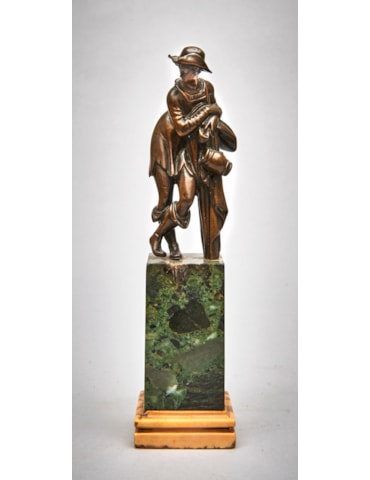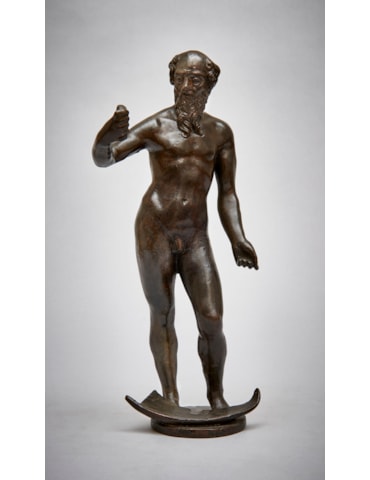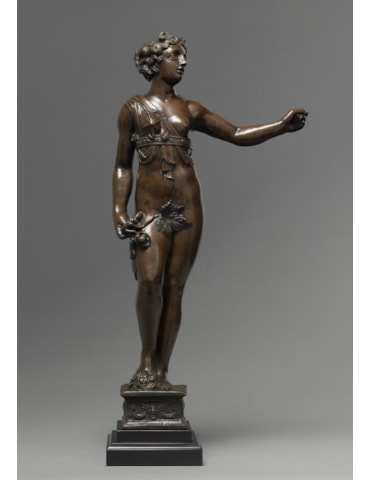Francesco Fanelli
Florence 1577 - after 1657?
Corpus Christi
Bronze with gilded loin cloth
Overall height: 20 cm / 8 in
Height from head to toe: 18 cm / 7 in
Overall width: 16 cm / 6¼ in
Overall height: 20 cm / 8 in
Height from head to toe: 18 cm / 7 in
Overall width: 16 cm / 6¼ in
ENQUIRIES
+44 (0)20 7259 0707
Some other known casts: Venice, Ca’ d’Oro (inv. no. br. 256), with gilded crown of thorns and loin cloth;2 Milan, private collection, with gilded crown of thorns and loin cloth;3 Florence, private collection, less finely finished, the loin cloth is neither gilded or chased; Cleveland, Art Institute.
Facture: The colour of the base metal is coppery and, with the exception of the loin cloth which retains its original gilding, the entire surface of the bronze has a natural warm, olive-brown patina. The modelling of the facial features, hair, finger and toe nails was exquisitely detailed in the wax prior to casting. Only the chasing and punching of the pattern in the loin cloth appears to have been carried out after casting.
Among the few images of Christ known by Fanelli, the life-size marble statue of Ecce Homo in the Cappella del Crocifisso, Il Gesù, Genoa, of 16254 exemplifies Fanelli’s imagery of Christ. In spite of the very considerable difference in scale and medium, many qualities of the Ecce Homo are also found in the present small Corpus, such as Christ’s neat facial type, the smooth modelling of His body and the tight, flattened folds of the drapery, one edge of which nervously flicks sharply upwards.
Shortly after he was documented working in Genoa, Fanelli is recorded to have made two bronze Corpora Christi for Gio. Domenico Spinola. A large Corpus, eight palmi in height, after a design by Giovanni Battista Paggi, was commissioned by Spinola on 23 April 1609.5 A smaller crucifix, three palmi in all, with a Corpus of one palmo, was commissioned by Spinola on 11 February 1610.6 Neither crucifix is known, and nor is Paggi’s design of 1609, though that may well resemble his Corpus Christi, painted in 1614, that hangs above the altar of the Crucifixion in the Santuario della Misericordia, Savona.7 Although the smaller Corpus (its height approximately 22 cm)8 commissioned of Fanelli by Spinola in 1610 is not described as being after a design by Paggi, it probably resembled the larger example that he had ordered from Fanelli less than a year earlier.
Like the present bronze, Paggi’s painting in the Misericordia, Savona depicts Christ ‘alive’, his head held up, although his feet are pierced by only one nail.
1. E. D. Schmidt, “Giovanni Bandini tra Marche e Toscana”, Nuovi Studi. Rivista di arte antica e moderna, vol. 6, 1998 anno III, pp. 57-103, pp. 75 & 102, n. 236 notes that Fanelli’s baptismal certificate records his birth in Florence on 17 December 1577. For evidence suggesting that Fanelli was still alive in Savona in 1657, see P. Wengraf, “Biography of Francesco Fanelli” in European Bronzes in the Quentin Collection, exh. cat., New York, The Frick Collection, 28 September 2004 – 2 January 2005, p. 329, n. 60.
2. A. Augusti & F. Saccardo, Ca’ d’Oro. La Galleria Giorgio Franchetti, Milan, 2000, p. 64, described as “Scuola fiorentina del XVII secolo”.
3. This cast (h. head to toes 19 cm and width of arm span is 15.7 cm) is signed “• V † P •” by a founder who has yet to be positively identified. The suggestion of the owner that V.P. might indicate the Perugian goldsmith Vincenzo Parmocchia (1527– 1571), Orefice, in Bulgari, vol III, Perugia, Umbria p. 294, is unlikely due to his having died before Fanelli was born. It is more likely to have been cast by a Genoese goldsmith working from Fanelli’s model.
4. E. Parma Armani & M. Clelia Galassi, “Artisti e Artigiani del Marmo dal Cinquecento al Seicento” in La Scultura a Genova e in Liguria. II. Dal Seicento al Primo Novecento, pp. 7-83, Genoa, 1988, pp. 62-63, fig. 70 & p. 79, erroneously stating that Fanelli’s Ecce Homo and Redeemer (p. 32, fig. 33) are in the Cappella Raggio, citing M. Labò, Il Gesù (S.S. Andrea e Ambrogio), Genoa 1932, p. 35. Both are in the Cappella del Crocifisso.
5. F. Alizeri, "Notizie dei professori del disegno" in Liguria dalla fondazione dall’Accademia, VI, Genoa, 1870, pp. 198-200.
6. Alizeri 1870, pp. 395-396.
7. E. Parma Armani, “Un Committente genovese per il Santuario della Misericordia di Savona tra Cinque e Seicento: Franco Borsotto”, Atti e Memorie, nuova serie, vol. XXIX, 1993, pp. 59-94 & illu. 8. Being unable to establish the precise measurement of the palmo genovese, we have assumed that it approximates to the palmo romano, i.e. 22.3cm.
Facture: The colour of the base metal is coppery and, with the exception of the loin cloth which retains its original gilding, the entire surface of the bronze has a natural warm, olive-brown patina. The modelling of the facial features, hair, finger and toe nails was exquisitely detailed in the wax prior to casting. Only the chasing and punching of the pattern in the loin cloth appears to have been carried out after casting.
Among the few images of Christ known by Fanelli, the life-size marble statue of Ecce Homo in the Cappella del Crocifisso, Il Gesù, Genoa, of 16254 exemplifies Fanelli’s imagery of Christ. In spite of the very considerable difference in scale and medium, many qualities of the Ecce Homo are also found in the present small Corpus, such as Christ’s neat facial type, the smooth modelling of His body and the tight, flattened folds of the drapery, one edge of which nervously flicks sharply upwards.
Shortly after he was documented working in Genoa, Fanelli is recorded to have made two bronze Corpora Christi for Gio. Domenico Spinola. A large Corpus, eight palmi in height, after a design by Giovanni Battista Paggi, was commissioned by Spinola on 23 April 1609.5 A smaller crucifix, three palmi in all, with a Corpus of one palmo, was commissioned by Spinola on 11 February 1610.6 Neither crucifix is known, and nor is Paggi’s design of 1609, though that may well resemble his Corpus Christi, painted in 1614, that hangs above the altar of the Crucifixion in the Santuario della Misericordia, Savona.7 Although the smaller Corpus (its height approximately 22 cm)8 commissioned of Fanelli by Spinola in 1610 is not described as being after a design by Paggi, it probably resembled the larger example that he had ordered from Fanelli less than a year earlier.
Like the present bronze, Paggi’s painting in the Misericordia, Savona depicts Christ ‘alive’, his head held up, although his feet are pierced by only one nail.
1. E. D. Schmidt, “Giovanni Bandini tra Marche e Toscana”, Nuovi Studi. Rivista di arte antica e moderna, vol. 6, 1998 anno III, pp. 57-103, pp. 75 & 102, n. 236 notes that Fanelli’s baptismal certificate records his birth in Florence on 17 December 1577. For evidence suggesting that Fanelli was still alive in Savona in 1657, see P. Wengraf, “Biography of Francesco Fanelli” in European Bronzes in the Quentin Collection, exh. cat., New York, The Frick Collection, 28 September 2004 – 2 January 2005, p. 329, n. 60.
2. A. Augusti & F. Saccardo, Ca’ d’Oro. La Galleria Giorgio Franchetti, Milan, 2000, p. 64, described as “Scuola fiorentina del XVII secolo”.
3. This cast (h. head to toes 19 cm and width of arm span is 15.7 cm) is signed “• V † P •” by a founder who has yet to be positively identified. The suggestion of the owner that V.P. might indicate the Perugian goldsmith Vincenzo Parmocchia (1527– 1571), Orefice, in Bulgari, vol III, Perugia, Umbria p. 294, is unlikely due to his having died before Fanelli was born. It is more likely to have been cast by a Genoese goldsmith working from Fanelli’s model.
4. E. Parma Armani & M. Clelia Galassi, “Artisti e Artigiani del Marmo dal Cinquecento al Seicento” in La Scultura a Genova e in Liguria. II. Dal Seicento al Primo Novecento, pp. 7-83, Genoa, 1988, pp. 62-63, fig. 70 & p. 79, erroneously stating that Fanelli’s Ecce Homo and Redeemer (p. 32, fig. 33) are in the Cappella Raggio, citing M. Labò, Il Gesù (S.S. Andrea e Ambrogio), Genoa 1932, p. 35. Both are in the Cappella del Crocifisso.
5. F. Alizeri, "Notizie dei professori del disegno" in Liguria dalla fondazione dall’Accademia, VI, Genoa, 1870, pp. 198-200.
6. Alizeri 1870, pp. 395-396.
7. E. Parma Armani, “Un Committente genovese per il Santuario della Misericordia di Savona tra Cinque e Seicento: Franco Borsotto”, Atti e Memorie, nuova serie, vol. XXIX, 1993, pp. 59-94 & illu. 8. Being unable to establish the precise measurement of the palmo genovese, we have assumed that it approximates to the palmo romano, i.e. 22.3cm.




